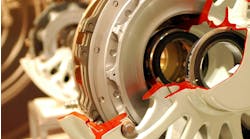When it comes to sizing a hydraulic reservoir, my motto and advice is: the bigger the better. Because the greater the tank volume the longer the dwell time the oil has to give up contaminants - particles, water and particularly air. Size DOES matter.
The rules of thumb for reservoir size - and that's all they are - differ for open and closed circuits. For a conventional reservoir used in open circuits the general rule is a tank oil capacity of 3 to 5 times the flow of the pump(s) per minute plus a 10 percent air cushion. For HFC and HFD fire-resistant fluids the general rule is 5 to 8 times pump flow per minute.
These ideals are easy enough to achieve on a stationary hydraulic machine in an industrial setting. In a mobile application it's a lot harder due to space and weight restrictions. For this reason, 1.5 to 2 times pump flow-rate is often a more realistic target for mobile machines. Realistic, but not necessarily ideal. So, for example, if I was designing a mobile hydraulic machine and it was possible to squeeze in a tank volume of say 2.5 times pump flow rate per minute - I'd definitely do it. Like I say, the bigger the better (within reason of course!).
That takes care of open circuit systems. But what about closed circuits (hydrostatic transmissions)? If the transmission pump has a flow rate of 100 gallons per minute, should the target tank volume be 300 to 500 gallons? No, that would be overkill. The flow rate of 100 gallons per minute is not passing through the tank. It is circulating in the transmission loop - pump to motor and back to pump.
But the charge pump on a hydrostatic transmission is open circuit, right? So how about 3 to 5 times the flow-rate of the charge pump per minute? If the transmission pump has a maximum flow-rate of 100 gallons per minute, then the charge pump would need to have a flow rate of at least 20 percent of that or 20 gallons per minute. Based on the 3 to 5 times rule, that equates to a tank volume of between 60 and 100 gallons. Certainly no harm in having a tank that size - if it can be accommodated. Once again, in a mobile application, 1 to 2 times charge pump flow per minute is probably more realistic.
These days, there are non-conventional reservoir designs which make possible smaller stored oil volumes, and therefore shorter dwell times, without compromising release of air from the oil. But when it comes to a conventional reservoir, skimping on stored oil volume is usually a mistake from reliability perspective. And to discover six other costly mistakes you want to be sure to avoid with your hydraulic equipment, get "Six Costly Mistakes Most Hydraulics Users Make... And How You Can Avoid Them!" available for FREE download here.
Sponsored Recommendations
May 15, 2024
March 13, 2024
March 13, 2024
March 13, 2024

